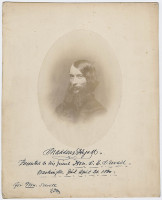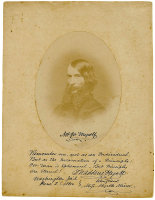|
Thaddeus Hyatt Portraits
Thaddeus Hyatt [1816-1901] is the inventor of the
 bull's-eye vault light of 1845,
designed to correct three problems with
Rockwell's 1834 single-lens design:
Hyatt's plate is safe to walk on even if all the glass is broken out, the
glass is protected from scratching by raised bumps on the ironwork, and the
glass is set in a band of lead or other soft metal to protect it from shock
and isolate it from expansion and contraction of the metal frame. He may
have been inspired during a London visit by
Christy's 1841 coal plate design
which uses several intermediate-size round glass lenses.
Hyatt's invention was not an immediate success: "It was about seven
years after the patent was granted before he succeeded in conquering the
prejudices of the public, and rendering his invention profitable"
(Hyatt's Patent Extension Case, 1859)
which was a decided factor in granting him the extension. Eventually his
Hyatt Lights caught on and made him a rich man.
bull's-eye vault light of 1845,
designed to correct three problems with
Rockwell's 1834 single-lens design:
Hyatt's plate is safe to walk on even if all the glass is broken out, the
glass is protected from scratching by raised bumps on the ironwork, and the
glass is set in a band of lead or other soft metal to protect it from shock
and isolate it from expansion and contraction of the metal frame. He may
have been inspired during a London visit by
Christy's 1841 coal plate design
which uses several intermediate-size round glass lenses.
Hyatt's invention was not an immediate success: "It was about seven
years after the patent was granted before he succeeded in conquering the
prejudices of the public, and rendering his invention profitable"
(Hyatt's Patent Extension Case, 1859)
which was a decided factor in granting him the extension. Eventually his
Hyatt Lights caught on and made him a rich man.
Thaddeus was interested in many things; he was a pioneer of reinforced
concrete construction (his patent No. 206,112 of 1878
was the first in the US); his interest in aviation led him in 1857-58
to offer "a reward of $1,000 to any inventor able to produce an actual
flying machine" and in 1882 he published a treatise on flight called
The Dragon-Fly, or Reactive Passive Locomotion.
His older brother Theodore [1814-1879] was also an inventor and held patents
on illuminated roofing (among other
things), but mainly he was the business-minded of the two. Together
they formed Hyatt Brothers.
But... "Thaddeus was a never-ending source of trouble to his brother,
chiefly because of his ineptitude in business matters. He seemed unable
to regulate his expenditures according to his income, his taxes were
frequently delinquent, and he was known to promise loans or gifts of
money which he did not have. Much of the burden of managing his financial
affairs fell to Theodore, and it was no easy task even to keep Thaddeus
solvent. For example, he had made promises, said Theodore in September,
that would obligate him to pay out something like $11,000 during the
next two or three months, which would amount to more than twice his
income for the same period." —Kansas Historical Society
"The fact is, ... unless
my poor demented, insane brother changes his course and husbands
his resources Heaven itself cannot save him from destruction, for
while he is wasting thousands of dollars on the infernal John Brown,
Washington Jail humbug his property heavily mortgaged is eating him up
with expense of interest, taxes & assessments amounting yearly to
over five thousand dollars, and not paying his taxes & assessments
when due his property is constantly sold & when redeemed costs
15 pct. and expenses equal to 20 pct—enough to ruin any man,
..." —Letter to W. F. M. Arny from Theodore (Kansas Historical Quarterly)
|
|
 |
 |
"Thaddeus Hyatt
Presented to his friend
Hon. S. E. Sewall
Washington Jail April 21 1860"
Scan: Massachusetts
Historical Society
Photo. 9.1.1114 |
"Not for Myself
Remember me, not as an individual,
But as the Incarnation of a Principle;
For Man is Ephemeral - But Principles
are Eternal!" [signed] Thaddeus Hyatt
Washington Jail, June 2d, 1860
to his friend, Miss Myrtle Minor."
Scan: Bonhams |
Outside of glass-collecting circles, Thaddeus is best
known as being a staunch and vocal abolitionist, becoming actively
involved after the passing of the Kansas-Nebraska Act,
which let the territory's voters decide the slavery issue. He used the
money from his vault lights to further the cause. He was a friend and
supporter of
John Brown,
who used his New York residence as headquarters when visiting the city
[NYT obit].
Following the Harpers Ferry raid
and Brown's execution, Thaddeus was jailed for refusing to testify before
a Senate investigative committee, arguing in a 23-page written response
that the Senate did not have the power to compel his presence. The Senate
voted to jail him, but he made light of his imprisonment, decorating his cell
and entertaining visitors in style. Eventually his case resulted in a Supreme
Court decision affirming Congress' right to summon witnesses; however three
months later the investigative committee was dissolved and Hyatt was freed.
He immediately telegraphed New York "Have been kicked out. Will be home
to-morrow." See Thaddeus Hyatt in Washington Jail
at the Kansas Historical Society.
Thaddeus continued his involvement in Kansas affairs, forming the
Kansas Relief Committee following the
devastating drought culminating in 1860,
and striving to help farmers impoverished by the drought.
Read more about Thaddeus at Wikipedia.
|